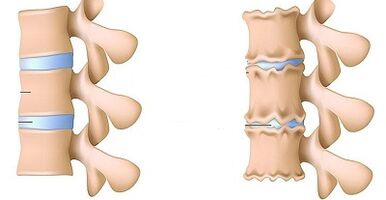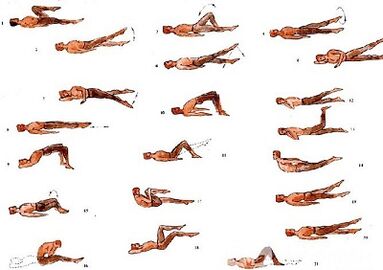
Lumbar osteochondria is a chronic disease that develops as a result of a degenerative double process in intervertebral discs.The disease is widespread and in most cases affects people from 25 to 40 years.
According to back pain statistics, at least once in the life of each second adult it experiences, while 95% of cases are due to the spine osteochondria.
Patients with a severe lumbar spine, with persistent pain and other manifestations are recognized as temporary people with disabilities.If within four months their condition does not improve, the issue of establishing a disability group has been resolved.
Lumbar osteochondria is a serious medical and social problem, as the disease mainly affects the people of the most working era and, in addition, in the absence of treatment, can cause the intervertebral disc hernia to form.
Causes and risk factors
The factors predisposed to the development of lumbar osteochondicity are:
- Anomalies of the spine structure.
- Near is a congenital pathology of the spine, characterized by the separation from the sanctuary of the first vertebra and its transformation into the sixth (additional) lumbar.
- Sacrifice is an innate pathology, in which the fifth lumbar spine is fueled by the sanctuary.
- The asymmetric position of the articular cracks of the intervertebral joints.
- Pathological stenosis of the spine.
- They reflected vertebral aches (physically and muscles).
- portliness;
- Lifestyle.
- prolonged exposure to vibration.
- Systematic physical stress.
- smoking.
The adverse gradual loads combined with one or more risk factors lead to a change in the normal properties of the nucleus of the jacket of an fibrous disc, playing a shock -degrading role and providing the mobility of the spine.The basis of this process is the supply of polysaccharides, which leads to the loss of moisture with a fabric of the nucleus of the jet.As a result, the core of the jacket, and with this, the fibrous disc loses their flexible properties.Further mechanical loads cause the protrusion of the fibrous ring that has lost elasticity.This phenomenon is called a protrusion.The cracks appear in the fibrous core, through which the fragments of the jacket core (prolapse, the intervertebral disc herniation) fall out.
A long compression of the nerve roots that encourage certain organs of the abdominal cavity over time leads to deterioration of their function.
The instability of the spine section is accompanied by reactive changes in the bodies of adjacent vertebrae, intervertebral joints and the consequent arthritis spine.A significant contraction of the muscles, for example, in the context of physical activity, leads to the shift of vertebral bodies and violating nerve roots with the development of radical syndrome.
Osteophytics may be another cause of pain and neurological symptoms with osteochondria - bone burst in processes and vertebral bodies that cause Ryshold syndrome or compression myelopathy (compression of the spinal cord).
Forms of the disease
Depending on the structures derived from the pathological process, lumbar osteochondria is clinically manifested by the following syndromes:
- Reflection- Lumbalgia, Lumbohachachalia, Lumbago.Develop in the context of the abuse of back muscle reflexes.
- compression (spine, vascular, radical)- Their growth leads to the compression (compression) of the spinal cord, blood vessels or nerve roots.Examples are lumbar radical, radical.
Lumbar symptoms
With lumbar osteochondria, the symptoms are determined by the structures that are drawn into the pathological process.
Lumbago appears under the influence of hypothermia or physical overrun, and sometimes for no apparent reason.Pain suddenly occurs and shot.It is introduced when sneezing, coughing, body turns, physical activity, seat, standing, walking.In place of lie, the pain weakens significantly.Sensitivity and reflexes are maintained, the volume of movements in the lumbar region is reduced.
In palpation, they observe:
- Pain in the lumbar region.
- Spasm of paranormal muscles.
- Lumbar lumbar leveling, which in many cases is combined with scoliosis.
The nerve root voltage syndrome is negative.When increasing an equal foot, patients mark the increase in lower back pain and not their appearance in an elongated lower end.
Often, with lumbar osteochondria, there is a repetitive appearance of pain attacks, which becomes increasingly intense and large.
With Lumbalia, the clinical picture looks like a lumbar, however, an increase in pain intensity occurs in a few days.
In lumbar school, patients complain about lower back pain, which radiate to one or both lower extremities.The pain spreads over the buttocks and the back of the thigh and never reaches the feet.
Angiomotor disorders are characteristic of lumbar base:
- Changes in temperature and color of the skin of the lower extremities.
- feeling of heat or cooling.
- Violation of blood supply.
The development of lumbar compression syndrome is clinically manifested by the following symptoms:
- Gipalgesia dermatomic.
- Shooting aches;
- weakening or complete loss of deep reflexes;
- Regional decline.
With compression syndromes, the pain is intensified during the inclination of the body, sneezing and cough.
Diagnosis
The diagnosis of lumbar osteochondicism is performed on the basis of the clinical picture of the disease, laboratory and organic research methods.
In the blood tests in the context of lumbar osteochondicity, it can be noted:
- Reduce calcium concentration.
- increase in ESR;
- Increasing the level of alkaline phosphatase.
In the diagnosis of lumbar osteochondicism, radiological examination of the spine is of great importance.
A long compression of the nerve roots that encourage certain organs of the abdominal cavity over time leads to deterioration of their function.
X -ray features that confirm the diagnosis are:
- Change in the configuration of the affected section.
- Pseudo -Line (shifting relevant spine).
- Deformation of the closure plates.
- leveling of the intervertebral disc.
- The uneven height of the intervertebral disc (symptom of the separator), which is associated with asymmetric muscle tone.

Also, in the diagnosis of lumbar osteochondicity in the presence of indications are used:
- Myelography, calculated or magnetic resonance imaging - are essential for persistent symptoms, the development of neurological deficiency.
- Saltography (the study of the accumulation of a bone phosphorus system, a tech-99-99)-is performed in the event of suspicion of volume or infectious process, spine injury.
The differential diagnosis of lumbar osteochondicity is performed with the following diseases:
- Spondylolistz?
- Strong spine.
- Ankylosing spondylitis (ankylosing spondylitis).
- Infectious processes (disk inflammation, spine osteomyelitis).
- Non -plastic processes (primary volume of the spine or metastatic lesions).
- Rheumatoid arthritis.
- distorted osteoarthy of the hip joint.
- Reflected pains (diseases of internal organs and large blood vessels).
Treatment of lumbar osteochondry
With lumbar osteochondria, they usually adhere to the following treatment tactics:
- bed rest for 2-3 days.
- the traction of the affected part of the spine.
- Enhancing back and abdominal muscle muscles (the creation of So -Called Muscle Corset).
- Impact on the pathological myodic and myotonic processes.
Lumbago appears under the influence of hypothermia or physical overrun, and sometimes for no apparent reason.
In most cases, a conservative treatment of lumbar osteochondrication is performed, including the following measures:
- Muscle infiltration with a solution of local anesthetic.
- Taking non -esotal anti -inflammatory drugs.
- receiving desensitizing factors;
- Treatment of vitamin.
- receiving sedatives and antidepressants;
- manual treatment, massage.
- Physiotherapy Physical Education.
- acupuncture;
- Transfiguration.
The absolute indications for surgical treatment of lumbar osteochondicism are:
- acute or subacute compression of the spinal cord.
- The development of horse tail syndrome, characterized by reduced function of pelvic organs, sensitive and motor disorders.
Medical gym for lumbar osteochondria

In the complex treatment of lumbar osteochondrication, an important role is part of physiotherapy exercises.Regular classes make it possible to normalize the muscular muscle tone, improve metabolic processes in tissues affected by the pathological process and in addition to forming a muscle corset, which can maintain the spine in the correct position.
In order for gymnastics with lumbar osteochondria to bring the greatest result to adhere to the following principles:
- regularity of classes;
- Gradually increasing the intensity of physical activity.
- Avoiding excessive work during the course.
Physical education should deal with the leadership of an experienced trainer who will choose the most effective exercises for a particular patient and control the correctness of their implementation.
According to back pain statistics, at least once in the life of each second adult it experiences, while 95% of cases are due to the spine osteochondria.
In addition to the classes with a trainer, you will have to perform a morning exercise complex daily, which includes special lumbar exercises.
- Relaxation and abdominal muscle contractions.The starting position is standing, the legs are shoulder -divided, the body hands are reduced.Make a smooth breathing by relaxing the muscles of the anterior abdominal wall.During the exhalation, pull yourself as much as possible, stretching the type muscles.Exercise must be repeated before light fatigue appearance.
- Movement of the head by bending the spine.The knee start position, resting on the floor from the back, the back is straight.Slowly lift your head and bend on the back.Stay in this position for a few seconds, and then return smoothly to its original position.Repeat at least 10-12 times.
- "Pendulum".The starting position on the back, the hands along the body, the legs are bent at right corners in the knee and hip joints.Turn the legs to the right and left with moving moving pending, trying to get the floor.At the same time, shoulders cannot be torn from the floor.
- "Vessel".The starting position in the stomach, the hands extend forward.Pull the upper part of the body and legs from the floor, bending to the back.Remain in this position for 5-6 seconds and return to the original position late.Run 10 times.
Possible consequences and complications
The main complications of lumbar osteochondicity are:
- The formation of the intervertebral hernia.
- Vegetable dystonian.
- Spondylolis, spondylolistz;
- osteophy?
- Vertebrae.
- Stenosis of the spine, leading to spinal cord compression and capable of causing persistent loss of work capacity and reducing the quality of life.
A long compression of the nerve roots that encourage certain organs of the abdominal cavity over time leads to deterioration of their function.As a result, patients have intestinal malfunctions (constipation, diarrhea, flatulence) and pelvic organs (urinary disorders, erectile dysfunction, coldness, infertility).
Forecast
Pain syndrome for lumbar osteochondria progresses in the form of removal and exacerbations.Lumbago lasts 10-15 days, after which the patient's condition improves, the pain recedes.The secondary diseases of the countries may interfere with a favorable effect.Often, with lumbar osteochondria, there is a repetitive appearance of pain attacks, which becomes increasingly intense and large.
In the complex treatment of lumbar osteochondrication, an important role is part of physiotherapy exercises.
Patients with a severe lumbar spine, with persistent pain and other manifestations are recognized as temporary people with disabilities.If within four months their condition does not improve, the issue of establishing a disability group has been resolved.
Prevention
Preventing the development of spine osteochondralness is the following measures:
- Refusal of smoking;
- Normalization of body weight.
- Improving the general fitness, active lifestyle.
- Avoiding provocative conditions (weight lifting, sharp movements, turns, slopes).

















































